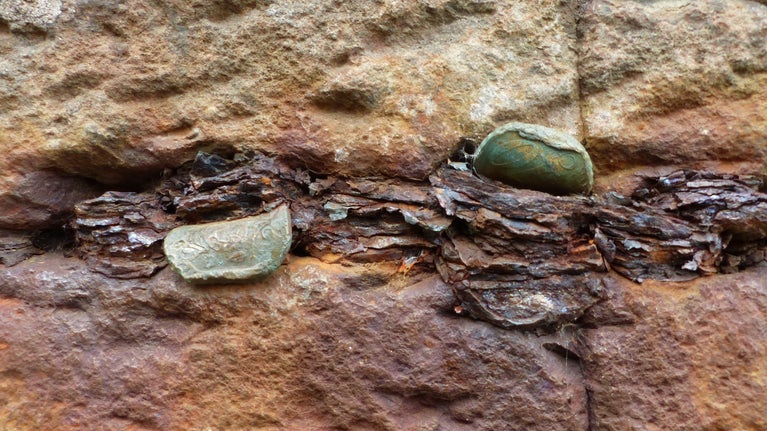giants-causeway-coins

Damage
The World Heritage Site is being damaged by coins being hammered by visitors into the cracks and joints
Corrosion
The coins rapidly corrode and expand which causes the rock to flake and leaves rust coloured streaks
Removal
A trial to remove coins safely has been successful and now it is hoped the coins - from all over the world – will be removed across the causeway
A giant issue with coins has emerged at the Giant’s Causeway, where a ritual by tourists to wedge coins into the cracks in the basalt rock columns of the Causeway is causing damage to the World Heritage Site.
With removal of coins expected to cost more than £30,000, we are appealing to visitors to stop the practice to protect the famous Northern Ireland landmark and to follow advice to “leave no trace” during a visit.
The causeway is said by legend to have been created by the giant Finn McCool and is one of Antrim’s most loved landmarks.
Dr Cliff Henry, National Trust Nature Engagement Officer at the Giant’s Causeway, said, “We know that visitors really love and cherish the Giant's Causeway, and many form deep personal connections to this special landscape. We know some may want to leave a token of their visit, but the coins are causing damage and we are urging people to stop the practice and to leave no trace so this natural wonder remains special for future generations.”
British Geological Survey report
A report by The British Geological Survey has concluded that the coins wedged into the joints and cracks in the rock is having a detrimental impact on the basalt rock of the Giant’s Causeway, both aesthetically and physically.
Dr Henry, explained the damage caused: “The report has found that fracturing and disintegration of the basalt rock adjacent to joints and cracks into which coins have been inserted is the result of the ‘expansive delamination of the coins upon oxidation’.
“In other words, the coins are rusting, and expanding to three times their original thickness, which puts huge pressure on the surrounding rock causing it to crumble. Unsightly streaks of copper, nickel and iron oxides are also staining the stones where the coins are corroding.”
Giant’s Causeway attracts visitors from all over the world and the coins found wedged in the rocks show the wide range of visitors. Most are from the UK or the Euro-zone , but others are from the far east, USA or elsewhere.
Ten test removal sites
The National Trust, in partnership with Causeway Coast and Glens Heritage Trust, employed specialists in stone conservation to remove as many of the coins as they could without causing further damage on ten test locations. The trial was successful, so it is hoped that all the remaining coins will also soon be removed. We are now appealing to visitors to help by not adding any more.
“It is hoped that if visitors see fewer coins in the stones and hear appeals to stop the damaging practice the problem can be solved.”
Corrosion
Dr Henry continued: “Many coins have a centre of one metal, with a thin coating of another. UK ‘copper’ coins, since 1992, have a steel core with only a thin layer of copper on the outside, while 5, 10 and 20 pence pieces are nickel-plated steel. When coins start to corrode, the steel often corrodes faster and separates from the different metal of the outer layer. This delamination causes the basalt to flake.
“The coins here also have accelerated corrosion because they are often soaked in saltwater spray and the mixture of metals means they break down faster.”
Our appeal
“We protect and care for places so people and nature can thrive. We are appealing to visitors to help us protect the World Heritage Site by stopping the practice of inserting coins into the Causeway stones.”
The National Trust is a conservation charity which protects and cares for more than 40,000 columns at the Giant’s Causeway, which is not only Northern Ireland’s first UNESCO World Heritage Site but benefits from a number of other important designations. They include being an Area of Special Scientific Interest, a Special Area of Conservation, a Natural Nature Reserve and part of the Causeway Coast Area of Outstanding Natural Beauty.
While geologists will say that the causeway was created by an outpouring of Basalt lava 60 million years ago around the time the North Atlantic was opening up, there are also legends that it was formed by an Irish giant Finn McCool. In one, he created a causeway to get across the Irish Sea to face his rival, the Scottish giant Benandonner, who tore up most of the causeway to prevent Finn from getting back to Scotland. Another legend has it that the causeway was built so Finn could meet a Scottish maid he was enamoured with.
Partner support
We have been working with a number of partners to help tackle this issue and we would like to thank Causeway Coast and Glens Heritage Trust, who have been instrumental in securing funding for the trials to remove the coins so far and in appointing Consarc Design Group to oversee the work so far. We would also like to thank our partners on the Giant’s Causeway World Heritage Site Steering Group for their support in helping care for the World Heritage Site.